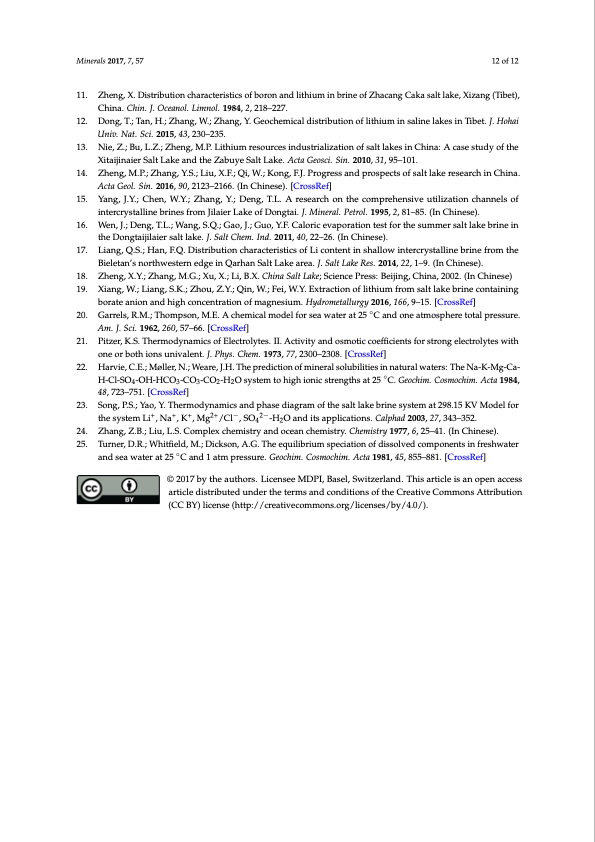
PDF Publication Title:
Text from PDF Page: 012
Minerals 2017, 7, 57 12 of 12 11. Zheng, X. Distribution characteristics of boron and lithium in brine of Zhacang Caka salt lake, Xizang (Tibet), China. Chin. J. Oceanol. Limnol. 1984, 2, 218–227. 12. Dong, T.; Tan, H.; Zhang, W.; Zhang, Y. Geochemical distribution of lithium in saline lakes in Tibet. J. Hohai Univ. Nat. Sci. 2015, 43, 230–235. 13. Nie, Z.; Bu, L.Z.; Zheng, M.P. Lithium resources industrialization of salt lakes in China: A case study of the Xitaijinaier Salt Lake and the Zabuye Salt Lake. Acta Geosci. Sin. 2010, 31, 95–101. 14. Zheng, M.P.; Zhang, Y.S.; Liu, X.F.; Qi, W.; Kong, F.J. Progress and prospects of salt lake research in China. Acta Geol. Sin. 2016, 90, 2123–2166. (In Chinese). [CrossRef] 15. Yang, J.Y.; Chen, W.Y.; Zhang, Y.; Deng, T.L. A research on the comprehensive utilization channels of intercrystalline brines from Jilaier Lake of Dongtai. J. Mineral. Petrol. 1995, 2, 81–85. (In Chinese). 16. Wen, J.; Deng, T.L.; Wang, S.Q.; Gao, J.; Guo, Y.F. Caloric evaporation test for the summer salt lake brine in the Dongtaijilaier salt lake. J. Salt Chem. Ind. 2011, 40, 22–26. (In Chinese). 17. Liang, Q.S.; Han, F.Q. Distribution characteristics of Li content in shallow intercrystalline brine from the Bieletan’s northwestern edge in Qarhan Salt Lake area. J. Salt Lake Res. 2014, 22, 1–9. (In Chinese). 18. Zheng, X.Y.; Zhang, M.G.; Xu, X.; Li, B.X. China Salt Lake; Science Press: Beijing, China, 2002. (In Chinese) 19. Xiang, W.; Liang, S.K.; Zhou, Z.Y.; Qin, W.; Fei, W.Y. Extraction of lithium from salt lake brine containing borate anion and high concentration of magnesium. Hydrometallurgy 2016, 166, 9–15. [CrossRef] 20. Garrels, R.M.; Thompson, M.E. A chemical model for sea water at 25 ◦C and one atmosphere total pressure. Am. J. Sci. 1962, 260, 57–66. [CrossRef] 21. Pitzer, K.S. Thermodynamics of Electrolytes. II. Activity and osmotic coefficients for strong electrolytes with one or both ions univalent. J. Phys. Chem. 1973, 77, 2300–2308. [CrossRef] 22. Harvie, C.E.; Møller, N.; Weare, J.H. The prediction of mineral solubilities in natural waters: The Na-K-Mg-Ca- H-Cl-SO4-OH-HCO3-CO3-CO2-H2O system to high ionic strengths at 25 ◦C. Geochim. Cosmochim. Acta 1984, 48, 723–751. [CrossRef] 23. Song, P.S.; Yao, Y. Thermodynamics and phase diagram of the salt lake brine system at 298.15 KV Model for the system Li+, Na+, K+, Mg2+/Cl−, SO42−-H2O and its applications. Calphad 2003, 27, 343–352. 24. Zhang, Z.B.; Liu, L.S. Complex chemistry and ocean chemistry. Chemistry 1977, 6, 25–41. (In Chinese). 25. Turner, D.R.; Whitfield, M.; Dickson, A.G. The equilibrium speciation of dissolved components in freshwater and sea water at 25 ◦C and 1 atm pressure. Geochim. Cosmochim. Acta 1981, 45, 855–881. [CrossRef] © 2017 by the authors. Licensee MDPI, Basel, Switzerland. This article is an open access article distributed under the terms and conditions of the Creative Commons Attribution (CC BY) license (http://creativecommons.org/licenses/by/4.0/).PDF Image | Lithium during Brine Evaporation and KCl Production Plants

PDF Search Title:
Lithium during Brine Evaporation and KCl Production PlantsOriginal File Name Searched:
minerals-07-00057-v2.pdfDIY PDF Search: Google It | Yahoo | Bing
Product and Development Focus for Infinity Turbine
ORC Waste Heat Turbine and ORC System Build Plans: All turbine plans are $10,000 each. This allows you to build a system and then consider licensing for production after you have completed and tested a unit.Redox Flow Battery Technology: With the advent of the new USA tax credits for producing and selling batteries ($35/kW) we are focussing on a simple flow battery using shipping containers as the modular electrolyte storage units with tax credits up to $140,000 per system. Our main focus is on the salt battery. This battery can be used for both thermal and electrical storage applications. We call it the Cogeneration Battery or Cogen Battery. One project is converting salt (brine) based water conditioners to simultaneously produce power. In addition, there are many opportunities to extract Lithium from brine (salt lakes, groundwater, and producer water).Salt water or brine are huge sources for lithium. Most of the worlds lithium is acquired from a brine source. It's even in seawater in a low concentration. Brine is also a byproduct of huge powerplants, which can now use that as an electrolyte and a huge flow battery (which allows storage at the source).We welcome any business and equipment inquiries, as well as licensing our turbines for manufacturing.| CONTACT TEL: 608-238-6001 Email: greg@infinityturbine.com | RSS | AMP |